light Acura TL 2000 3.2 Owners Manual
[x] Cancel search | Manufacturer: ACURA, Model Year: 2000, Model line: TL, Model: Acura TL 2000Pages: 311, PDF Size: 3.05 MB
Page 270 of 311
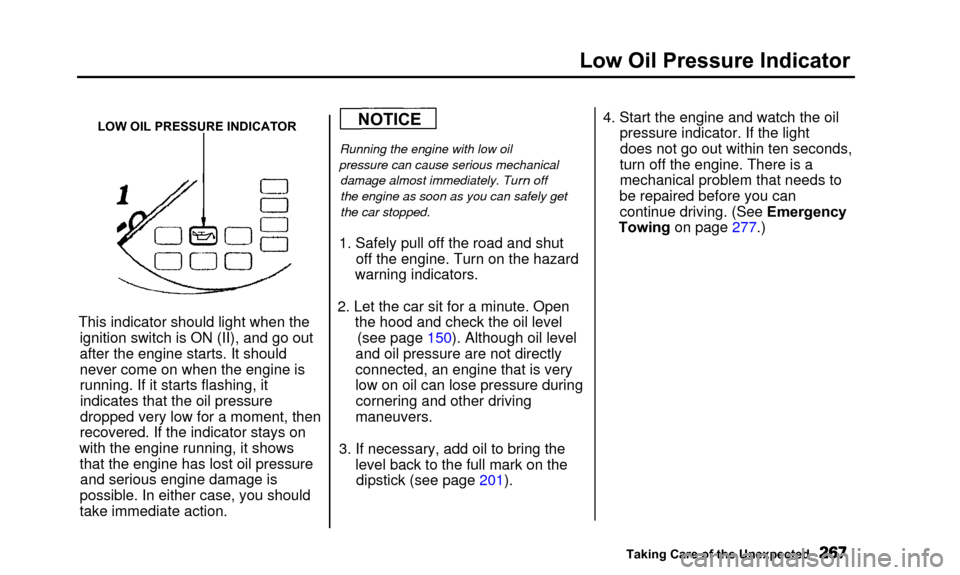
Low Oil Pressure Indicator
LOW OIL PRESSURE INDICATOR
This indicator should light when theignition switch is ON (II), and go out
after the engine starts. It should
never come on when the engine is
running. If it starts flashing, itindicates that the oil pressure
dropped very low for a moment, then
recovered. If the indicator stays on
with the engine running, it shows that the engine has lost oil pressureand serious engine damage is
possible. In either case, you should
take immediate action.
Running the engine with low oil
pressure can cause serious mechanical damage almost immediately. Tu
rn off
the engine as soon as you can safely get
the car stopped.
1. Safely pull off the road and shut off the engine. Turn on the hazard
warning indicators.
2. Let the car sit for a minute. Open the hood and check the oil level(see page 150). Although oil level
and oil pressure are not directly
connected, an engine that is very
low on oil can lose pressure during cornering and other driving
maneuvers.
3. If necessary, add oil to bring the level back to the full mark on thedipstick (see page 201). 4. Start the engine and watch the oil
pressure indicator. If the lightdoes not go out within ten seconds,
turn off the engine. There is a
mechanical problem that needs to
be repaired before you can continue driving. (See Emergency
Towing on page 277.)
Taking Care of the Unexpected
NOTICE
Page 273 of 311

Brake System Indicator
BRAKE SYSTEM INDICATOR
The Brake System Indicator lightcomes on when you turn the ignitionON (II). If the parking brake is not
set, it goes off after you start the
engine. If the parking brake is set, it
goes off when you fully release the parking brake with the engine
running. If it comes on at any other time, it
indicates a problem with the car's
brake system. In most cases, the problem is a low fluid level in the
brake fluid reservoir. Press lightly on
the brake pedal to see if it feels normal. If it does, check the brake
fluid level the next time you stop at a service station (see page 214). If the
fluid level is low, take the car to your dealer and have the brake system
inspected for leaks or worn brake
pads.
However, if the brake pedal does not
feel normal, you should take immediate action. Because of the
brake system's dual-circuit design, a
problem in one part of the system will still give you braking at two
wheels. You will feel the brake pedal
go down much farther before the car
begins to slow down, and you will
have to press harder on the pedal.
The distance needed to stop will be much longer. Slow down by shifting to a lower
gear, and pull to the side of the road
when it is safe. Because of the longer distance needed to stop, it is
hazardous to drive the car. Youshould have it towed, and repaired as
soon as possible. (See Emergency
Towing on page 277.)
If you must drive the car a shortdistance in this condition, driveslowly and cautiously.
Taking Care of the Unexpected
Page 276 of 311
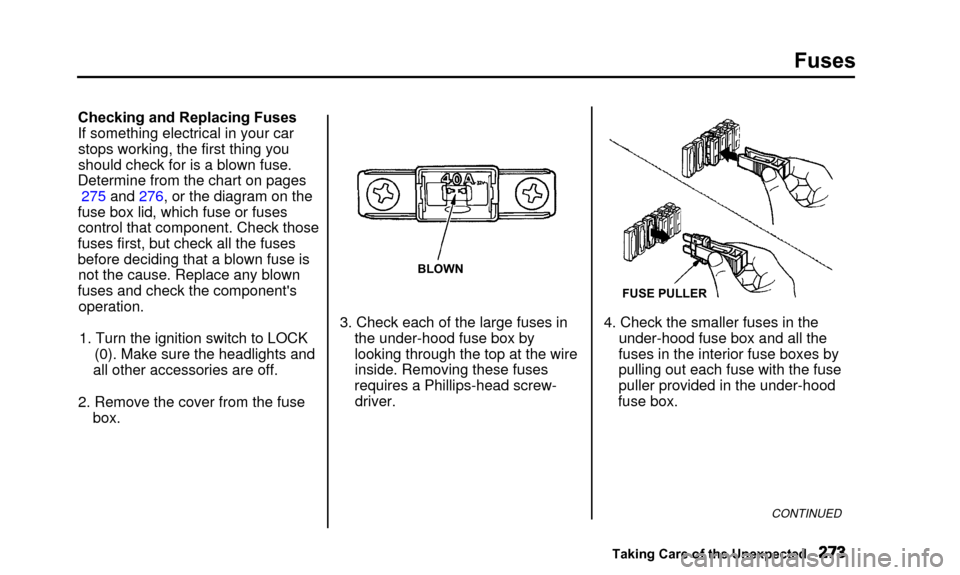
Fuses
Checking and Replacing Fuses
If something electrical in your car stops working, the first thing you
should check for is a blown fuse.
Determine from the chart on pages 275 and 276, or the diagram on the
fuse box lid, which fuse or fuses control that component. Check those
fuses first, but check all the fuses
before deciding that a blown fuse is not the cause. Replace any blown
fuses and check the component's operation.
1. Turn the ignition switch to LOCK (0). Make sure the headlights and
all other accessories are off.
2. Remove the cover from the fuse box.
BLOWN
3. Check each of the large fuses inthe under-hood fuse box by
looking through the top at the wireinside. Removing these fuses
requires a Phillips-head screw- driver.
FUSE PULLER
4. Check the smaller fuses in the under-hood fuse box and all the
fuses in the interior fuse boxes by
pulling out each fuse with the fuse
puller provided in the under-hood
fuse box.
CONTINUED
Taking Care of the Unexpected
Page 278 of 311

Fuses
UNDER-HOOD FUSE BOXNo.1
2
3
4 5
6
7
8
9
10 11 Amps.
20 A-
20 A
20 A 20 A15 A -
30 A 15 A
120 A 20 A Circuits Protected
Left Headlight
Not Used
Right Headlight
ABS F/S Stop
ACG
Spare Fuse
ABS Motor
Hazard
BatteryCooling FanNo.
1213
14
15
16
17
18 19
20
21 Amps.
30 A
40 A-
40 A
20 A
40 A
40A
50 A 15 A
20 A Circuits Protected
Back Up, ACC Power Window Motor
Spare Fuse
Power Seat
TCS Heater Motor
Rear Defroster
IG1 Main
Small Light
Condenser Fan
CONTINUED
Taking Care of the Unexpected
Page 279 of 311

Fuses
INTERIOR FUSE BOXES
DRIVER'S SIDE
No.1
2
3
4 5
6
7
8 9
10
11 12
13 Amps.
15 A
10 A
7.5 A
7.5 A
7.5 A
15 A
7.5 A
7.5 A 7.5 A
7.5 A 15 A
30 A
7.5 A Circuits Protected
Fuel Pump
SRS
Heater Control
Mirror
Daytime Running Lights*
ECU (ECM/PCM), Cruise Control
SRS
ACC Instrument Panel, Back-up
Lights, Moonroof
IG1 Turn Signals
IG1 Coil
Wiper, Washer Starter Signal PASSENGER'S SIDE
* : On Canadian models
No.
1
2
3
4
5
6 7
8
9
10
11
12
13
14
15
16 Amps.
30 A
20 A
20 A
20 A
20 A
20 A 20 A
20 A
20 A 10 A
7.5 A 20 A
7.5 A
7.5 A 20 A
20 A Circuits Protected
Moonroof
Power Seat Recline
Heated Seat
Driver's Power Seat
Assistant Power Seat Seat Recline
Rear Left Power Window
Front Right Power Window
ACC (Radio) Navigation System, Daytime
Running Lights*
Interior Light, Courtesy
Lights
Power Door Locks
Clock
ABS Motor Check
Driver's Power Window
Rear Right Power Window
* : On Canadian models
Taking Care of the Unexpected
Page 286 of 311
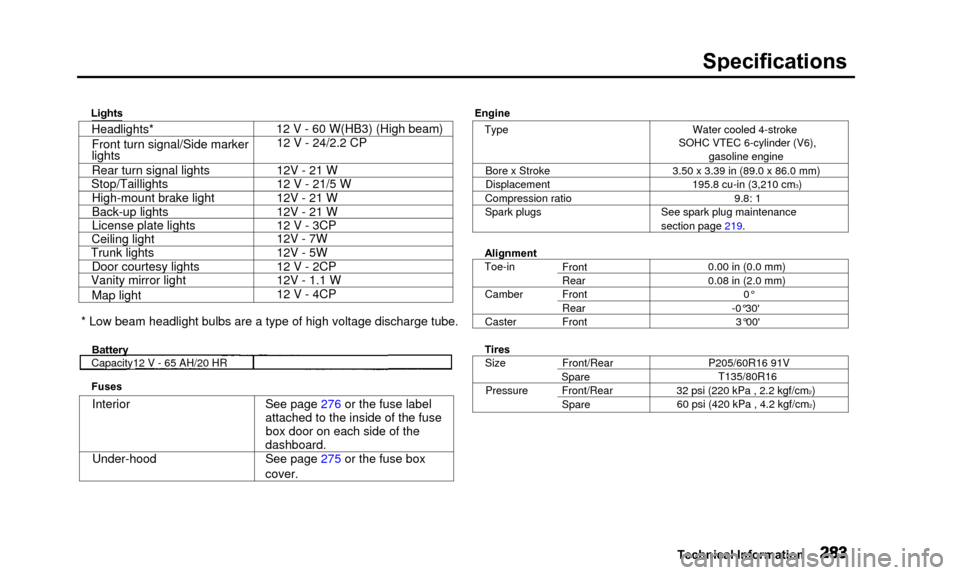
Specifications
Lights
TypeBore x Stroke
Displacement
Compression ratio
Spark plugs
Alignment
Toe-in Camber
Caster
Tires Size
Pressure Front
Rear
Front
Rear
Front
Front/Rear
Spare Front/Rear
Spare Water cooled 4-stroke
SOHC VTEC 6-cylinder (V6), gasoline engine
3.50 x 3.39 in (89.0 x 86.0 mm) 195.8 cu-in (3,210 cm
3)
9.8: 1
See spark plug maintenance
section page 219.
0.00 in (0.0 mm)
0.08 in (2.0 mm)0°
-0°30' 3°00'
P205/60R16 91V T135/80R16
32 psi (220 kPa , 2.2 kgf/cm
2)
60 psi (420 kPa , 4.2 kgf/cm2)
Technical Information
Headlights* Front turn signal/Side marker
lights
Rear turn signal lights
Stop/Taillights
High-mount brake light
Back-up lights
License plate lights
Ceiling light
Trunk lights
Door courtesy lights
Vanity mirror light
Map light 12 V - 60 W(HB3) (High beam)
12 V - 24/2.2 CP
12V - 21 W
12 V - 21/5 W
12V - 21 W
12V - 21 W
12 V - 3CP
12V - 7W
12V - 5W
12 V - 2CP
12V - 1.1 W
12 V - 4CP
* Low beam headlight bulbs are a type of high voltage discharge tube.
Battery
Fuses
Interior
Under-hood See page 276 or the fuse label
attached to the inside of the fuse
box door on each side of the
dashboard.
See page 275 or the fuse box
cover.
Capacity12 V - 65 AH/20 HR
Engine
Page 291 of 311
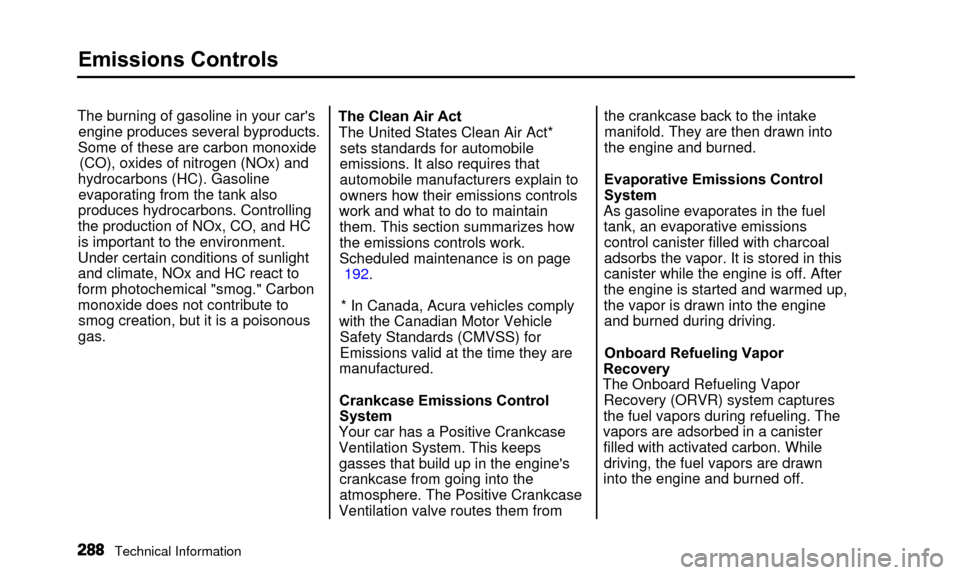
Emissions Controls
The burning of gasoline in your car'sengine produces several byproducts.
Some of these are carbon monoxide (CO), oxides of nitrogen (NOx) and
hydrocarbons (HC). Gasoline evaporating from the tank also
produces hydrocarbons. Controlling the production of NOx, CO, and HC
is important to the environment.
Under certain conditions of sunlight
and climate, NOx and HC react to
form photochemical "smog." Carbon monoxide does not contribute tosmog creation, but it is a poisonous
gas. The Clean Air Act
The United States Clean Air Act* sets standards for automobile
emissions. It also requires that
automobile manufacturers explain to
owners how their emissions controls
work and what to do to maintain them. This section summarizes how
the emissions controls work.
Scheduled maintenance is on page 192.
* In Canada, Acura vehicles comply
with the Canadian Motor Vehicle Safety Standards (CMVSS) for
Emissions valid at the time they are
manufactured.
Crankcase Emissions Control
System
Your car has a Positive Crankcase
Ventilation System. This keeps gasses that build up in the engine'scrankcase from going into the
atmosphere. The Positive Crankcase
Ventilation valve routes them from the crankcase back to the intake
manifold. They are then drawn into
the engine and burned.
Evaporative Emissions Control
System
As gasoline evaporates in the fuel tank, an evaporative emissionscontrol canister filled with charcoal
adsorbs the vapor. It is stored in this
canister while the engine is off. After
the engine is started and warmed up,
the vapor is drawn into the engine and burned during driving.
Onboard Refueling Vapor
Recovery
The Onboard Refueling Vapor Recovery (ORVR) system captures
the fuel vapors during refueling. The
vapors are adsorbed in a canister filled with activated carbon. Whiledriving, the fuel vapors are drawn
into the engine and burned off.
Technical Information
Page 302 of 311
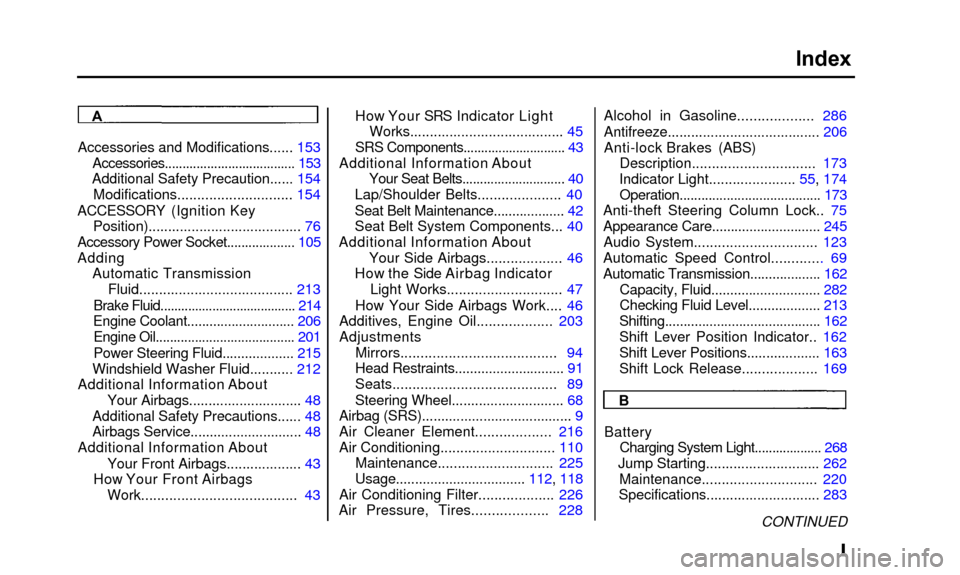
Index
Accessories and Modifications...... 153
Accessories..................................... 153
Additional Safety Precaution...... 154
Modifications............................. 154
ACCESSORY (Ignition Key Position)........ .............................. . 76
Accessory Power Socket......... .......... 105
Adding Automatic Transmission Fluid......... .............................. 213
Brake Fluid......... .............................. 214
Engine Coolant......... .................... 206
Engine Oil....................................... 201
Power Steering Fluid................... 215
Windshield Washer Fluid......... .. 212
Additional Information About Your Airbags........ ..................... 48
Additional Safety Precautions...... 48
Airbags Service........ ..................... 48
Additional Information About
Your Front Airbags................... 43
How Your Front Airbags Work........ .............................. . 43How Your SRS Indicator Light
Works....................................... 45
SRS Components............................. 43
Additional Information About Your Seat Belts........ ..................... 40
Lap/Shoulder Belts..................... 40
Seat Belt Maintenance................... 42
Seat Belt System Components... 40
Additional Information About Your Side Airbags................... 46
How the Side Airbag Indicator Light Works............................. 47
How Your Side Airbags Work.... 46
Additives, Engine Oil................... 203
Adjustments Mirrors....................................... 94
Head Restraints........ ..................... 91
Seats........................................ . 89
Steering Wheel............................ . 68
Airbag (SRS)....................................... 9
Air Cleaner Element................... 216
Air Conditioning............................. 110
Maintenance......... .................... 225
Usage................................. . 112, 118
Air Conditioning Filter......... .......... 226
Air Pressure, Tires......... .......... 228Alcohol in Gasoline................... 286
Antifreeze.........
.............................. 206
Anti-lock Brakes (ABS) Description......... ...................... 173
Indicator Light......... ............. 55, 174
Operation....................................... 173
Anti-theft Steering Column Lock.. 75
Appearance Care............................. 245 Audio System............................... 123
Automatic Speed Control........ ..... 69
Automatic Transmission......... .......... 162
Capacity, Fluid............................. 282
Checking Fluid Level................... 213
Shifting.......................................... 162
Shift Lever Position Indicator.. 162
Shift Lever Positions................... 163
Shift Lock Release......... .......... 169
A
B
Battery Charging System Light................... 268
Jump Starting......... .................... 262
Maintenance............................. 220
Specifications......... .................... 283
CONTINUED
Page 303 of 311
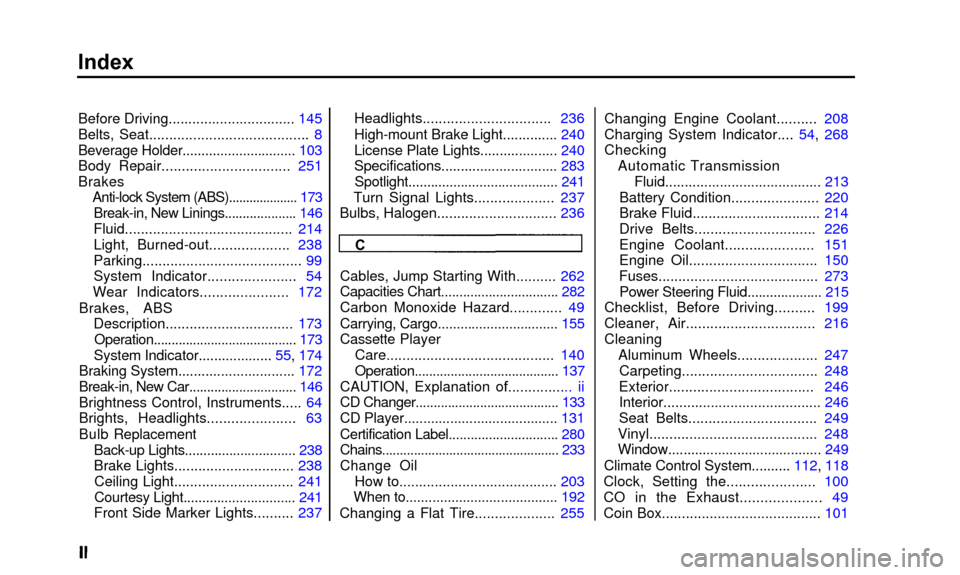
Index
Before Driving................................ 145
Belts, Seat........................................ 8
Beverage Holder.......... .................... 103
Body Repair.......... ...................... 251
Anti-lock System (ABS).......... .......... 173
Break-in, New Linings.......... .......... 146
Fluid.......................................... 214
Light, Burned-out.......... .......... 238
Parking........................................ 99
System Indicator...................... 54
Wear Indicators.......... ............ 172
Brakes, ABS Description................................ 173Operation........................................ 173
System Indicator....... ............ 55, 174
Braking System.............................. 172
Break-in, New Car.......... .................... 146
Brightness Control, Instruments... .. 64
Brights, Headlights...................... 63
Bulb Replacement Back-up Lights.............................. 238
Brake Lights.............................. 238Ceiling Light.............................. 241
Courtesy Light.......... .................... 241
Front Side Marker Lights.......... 237 Headlights..........
...................... 236
High-mount Brake Light.......... .... 240
License Plate Lights.......... .......... 240
Specifications.............................. 283
Spotlight........................................ 241
Turn Signal Lights.................... 237
Bulbs, Halogen.......... .................... 236Changing Engine Coolant.......... 208
Charging System Indicator.... 54, 268
Checking
Automatic Transmission Fluid........................................ 213
Battery Condition...................... 220
Brake Fluid................................ 214
Drive Belts.......... .................... 226
Engine Coolant.......... ............ 151
Engine Oil................................ 150
Fuses........................................ 273 Power Steering Fluid.......... .......... 215
Checklist, Before Driving.......... 199
Cleaner, Air................................ 216
Cleaning
Aluminum Wheels.......... .......... 247
Carpeting.................................. 248
Exterior.......... .......................... 246
Interior.......... .............................. 246
Seat Belts................................ 249
Vinyl.......................................... 248
Window........................................ 249
Climate Control System.......... 112, 118
Clock, Setting the...................... 100
CO in the Exhaust......... ........... 49
Coin Box........................................ 101
C
Cables, Jump Starting With .......... 262
Capacities Chart................................ 282
Carbon Monoxide Hazard............. 49
Carrying, Cargo ................................ 155
Cassette Player Care.......................................... 140
Operation........................................ 137
CAUTION, Explanation of................ ii
CD Changer........................................ 133
CD Player........................................ 131
Certification Label.............................. 280
Chains.................................................. 233
Change Oil How to........................................ 203
When to........................................ 192
Changing a Flat Tire.................... 255
Brakes
Page 304 of 311
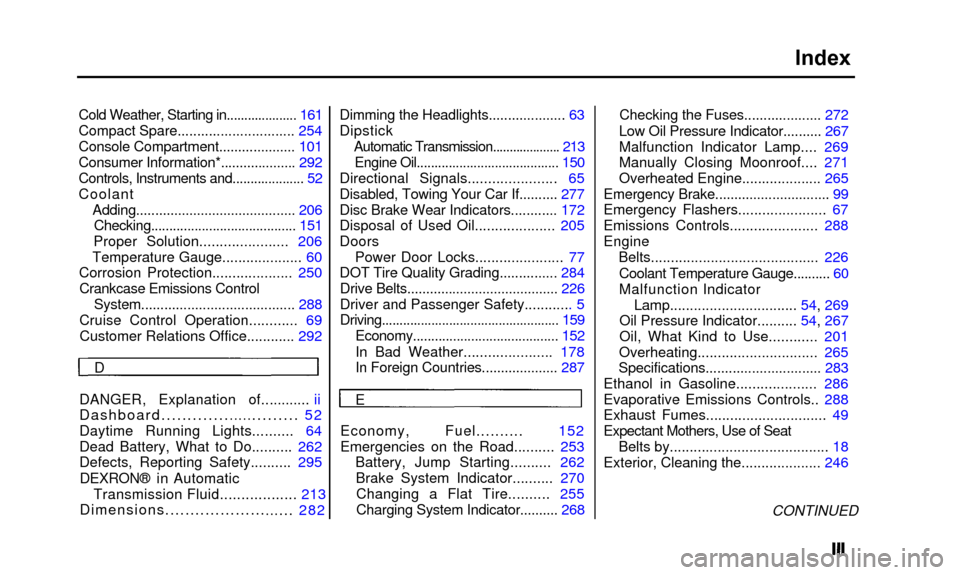
Index
Cold Weather, Starting in.................... 161
Compact Spare.............................. 254
Console Compartment.......... .......... 101
Consumer Information*.......... .......... 292
Controls, Instruments and.................... 52
Coolant
Adding.......................................... 206 Checking........................................ 151
Proper Solution...................... 206
Temperature Gauge.................... 60
Corrosion Protection.......... .......... 250
Crankcase Emissions Control System........................................ 288
Cruise Control Operation.......... .. 69
Customer Relations Office............ 292 Dimming the Headlights.........
........... 63
Dipstick Automatic Transmission.......... .......... 213
Engine Oil.......... .............................. 150
Directional Signals......... ............. 65
Disabled, Towing Your Car If.......... 277
Disc Brake Wear Indicators............ 172
Disposal of Used Oil.......... .......... 205
Doors Power Door Locks......... ............. 77
DOT Tire Quality Grading.......... ..... 284
Drive Belts.......... .............................. 226
Driver and Passenger Safety............ 5
Driving.................................................. 159
Economy........................................ 152
In Bad Weather.......... ............ 178
In Foreign Countries.................... 287 Checking the Fuses.................... 272
Low Oil Pressure Indicator.......... 267
Malfunction Indicator Lamp.... 269
Manually Closing Moonroof.... 271
Overheated Engine..........
.......... 265
Emergency Brake.............................. 99
Emergency Flashers...................... 67
Emissions Controls...................... 288
Engine Belts.......................................... 226
Coolant Temperature Gauge.......... 60
Malfunction IndicatorLamp................................ 54, 269
Oil Pressure Indicator.......... 54, 267
Oil, What Kind to Use.......... .. 201
Overheating.............................. 265
Specifications.......... .................... 283
Ethanol in Gasoline.................... 286
Evaporative Emissions Controls.. 288
Exhaust Fumes......... ..................... 49
Expectant Mothers, Use of Seat Belts by........................................ 18
Exterior, Cleaning the.......... .......... 246
CONTINUED
D
DANGER, Explanation of...
......... ii
Dashboard.............
.............. 52
Daytime Running Lights.......... 64
Dead Battery, What to Do.......... 262
Defects, Reporting Safety.......... 295
DEXRON® in Automatic Transmission Fluid.................. 213
Dimensions....................
...... 282 E
Economy, Fuel.......... 152
Emergencies on the Road.......... 253 Battery, Jump Starting.......... 262Brake System Indicator.......... 270Changing a Flat Tire.......... 255Charging System Indicator.......... 268